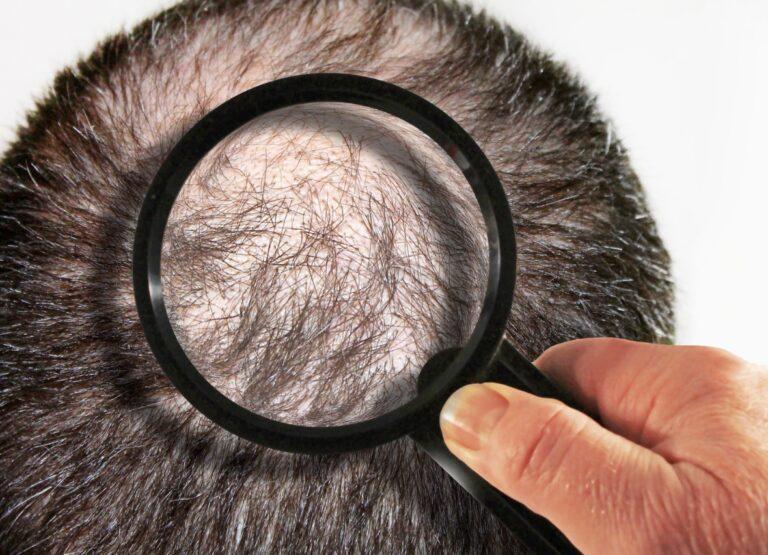Had that hair moment? The one where you catch yourself in the mirror or see a photo and your hair isn’t looking quite how it used to? Don’t worry. Hair loss happens to most of us. And even better news, there are things you can do to tackle it. Here we’ll tell you what a receding hairline is, what causes it and what you can do about it.
What is a receding hairline?
Your hairline is the line of hair above your face where forehead becomes scalp. A receding hairline is when your hair begins to thin and you lose your original hairline. There isn’t an exact number for how many men get a receding hairline, but it’s more likely to happen to you as you get older. It can occur as early as puberty, but it’s more common in men in their 30’s and over, and affects over half of men in their 50’s.
What does a receding hairline look like?
Look out for these signs of a receding hairline. At first you may notice your hairline becoming thinner as your hair gradually gets finer and shorter. As you start to lose hair you’ll get bald areas along your hairline where you used to have hair. These areas can make it look like your forehead is growing more prominent as your hairline moves backwards.
Usually hair isn’t lost evenly along the hairline. Typically more falls out at the corners above your temples, giving you a V-shaped hairline with a peak in the center and bald areas either side.
What causes a receding hairline?
A range of things can make your hair thin and fall out, but these are some of the most common receding hairline causes.
Stress and traumatic events
High levels of stress as well as traumatic events like surgery and illness can disrupt your hair’s growth cycle and make it thin and fall out. These can even include crash diets. This type of hair loss is called telogen effluvium and baldness tends to happen quickly, but hair usually returns once the underlying cause is gone.
Medical treatments
Some medical treatments like radiotherapy and chemotherapy can also cause your hair to fall out. Hair often falls out rapidly, usually in clumps at first, but then all over. The hair follicles (the areas in your skin that produce hair) aren’t damaged, so hair returns in most people once the treatment has finished.
Your lifestyle
There may be a link between some of your lifestyle choices and hair loss. There’s evidence that a poor diet can cause baldness, mainly if you don’t eat enough protein and specific nutrients, including niacin and biotin. Smoking can also increase your chances of hair loss.
Male pattern baldness
While the above can cause hair loss and can make your hairline recede, they typically cause hair to be lost all over the head. But if your hairline is receding slowly and hair on other areas of your head is still thick, especially at the sides of your head, chances are you have male pattern baldness (MPB).
MPB is the most common cause of hair loss in men. The term comes from the fact that hair recedes in a specific pattern, usually beginning with a receding at the front as well as the crown which will see you losing hair on the top of your head. As it progresses and more hair is lost these two areas can join up and you can lose all the hair on top of your scalp. Some men keep the hair on the sides of their head whereas some go bald entirely.
Does your hairline recede with age?
The cause of MPB is a combination of hormones, genetics and ageing. A hormone made from testosterone called dihydrotestosterone (DHT) shrinks your hair follicles over time, meaning they produce shorter and thinner hair until the follicle closes and produces no hair at all. Specific genes make this more likely meaning MPB does run in families. The ageing process is also involved; the older you get the more likely you are to develop MPB.
How can I restore my hairline?
So, can you fix a receding hairline or do you just have to deal with it? Well, this will depend on what’s causing your hair loss. If it’s due to stress, trauma or your lifestyle your hair should return once you address what’s causing it to fall out. You can find ways to manage stress and trauma, quit smoking, improve your diet and take a multivitamin. If a medical treatment causes balding, your hair will likely grow back after the treatment has ended.
But MPB is different. If left untreated MPB is permanent. Your hair loss will get worse over time and it won’t grow back. But thankfully you do have options for receding hairline treatments.
A hair transplant
A hair transplant is a surgical procedure where healthy hair follicles are removed from one part of your head (usually at the back above your neck) and transplanted into the areas where you’ve lost it. Hair transplants are useful, but they can be costly. You may need to have more operations over time too as their effects can be temporary.
Change your hairstyle
A cheaper option than a hair transplant is to style it out and change your cut. There is loads of advice online about the best receding hairline haircuts, but it’s probably best to go and see a hairstylist and find one that works for you.
Finasteride
A better option may fall between these two; a solution that’s less drastic than a hair transplant and more effective than changing your hairstyle. Finasteride.
Finasteride (the same active ingredient as Propecia) is a prescription drug that is medically proven to treat MPB. It works by reducing the level of DHT in your scalp, it can halt balding and even return lost hair. It’s a prescription drug, but you can order finasteride tablets directly from us. Start your online consultation and our doctors will assess your condition and can prescribe your hair loss treatment remotely.
The takeaway
MPB doesn’t have to mean the end of your hair. By tackling the problem early with the right meds you can be sure to keep your hair game strong.
Sources
Medical Disclaimer
NowPatient has taken all reasonable steps to ensure that all material is factually accurate, complete, and current. However, the knowledge and experience of a qualified healthcare professional should always be sought after instead of using the information on this page. Before taking any drug, you should always speak to your doctor or another qualified healthcare provider.
The information provided here about medications is subject to change and is not meant to include all uses, precautions, warnings, directions, drug interactions, allergic reactions, or negative effects. The absence of warnings or other information for a particular medication does not imply that the medication or medication combination is appropriate for all patients or for all possible purposes.







